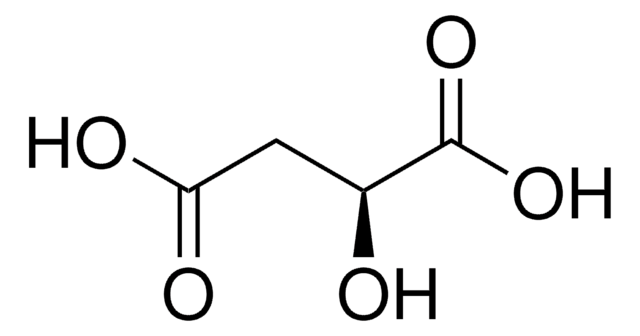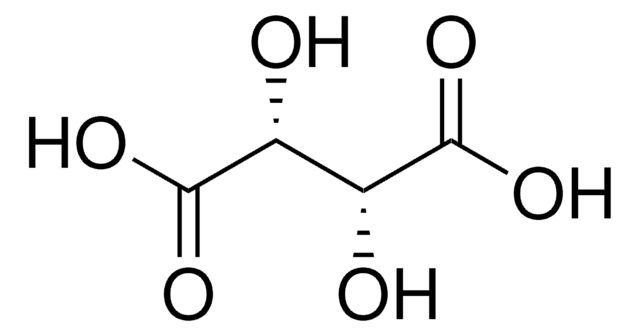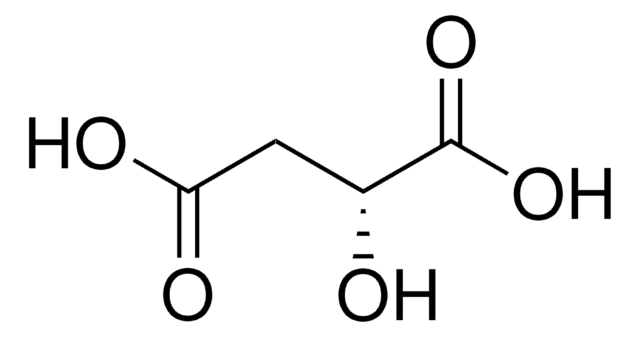27606
DL-Malic acid
meets analytical specification of FCC, E296, 99-100.5% (alkalimetric)
Sinónimos:
(±)-2-Hydroxysuccinic acid, DL-Hydroxybutanedioic acid
About This Item
Productos recomendados
densidad de vapor
4.6 (vs air)
presión de vapor
<0.1 mmHg ( 20 °C)
Ensayo
99-100.5% (alkalimetric)
Formulario
solid
actividad óptica
[α]/D −0.10 to +0.10°
temp. de autoignición
644 °F
calidad
meets analytical specification of FCC, E296
técnicas
IR spectroscopy: suitable
impurezas
≤0.05% maleic acid
≤0.1% water insoluble matter
≤1% fumaric acid
residuo de ign.
≤0.1% (as SO4)
mp
129-133 °C
131-133 °C (lit.)
solubilidad
acetone: soluble 17.75 g/ 100 gm at 20 °C
diethyl ether: soluble 0.84 g/100 gm at 20 °C
dioxane: soluble 22.70 g/100 gm at 20 °C
ethanol: soluble 45.53 g/100 gm at 20 °C
methanol: soluble 82.70 g/100 g at 20 °C
water: soluble 55.8 g/100 gm at 20 °C
benzene: insoluble
trazas de catión
As: ≤3 mg/kg
Hg: ≤1 mg/kg
Pb: ≤2 mg/kg
idoneidad
complies for identity (IR)
aplicaciones
pharmaceutical (small molecule)
cadena SMILES
OC(CC(O)=O)C(O)=O
InChI
1S/C4H6O5/c5-2(4(8)9)1-3(6)7/h2,5H,1H2,(H,6,7)(H,8,9)
Clave InChI
BJEPYKJPYRNKOW-UHFFFAOYSA-N
¿Está buscando productos similares? Visita Guía de comparación de productos
Aplicación
Acciones bioquímicas o fisiológicas
Palabra de señalización
Warning
Frases de peligro
Consejos de prudencia
Clasificaciones de peligro
Eye Irrit. 2
Código de clase de almacenamiento
11 - Combustible Solids
Clase de riesgo para el agua (WGK)
WGK 1
Punto de inflamabilidad (°F)
397.4 °F
Punto de inflamabilidad (°C)
203 °C
Equipo de protección personal
dust mask type N95 (US), Eyeshields, Gloves
Elija entre una de las versiones más recientes:
¿Ya tiene este producto?
Encuentre la documentación para los productos que ha comprado recientemente en la Biblioteca de documentos.
Los clientes también vieron
Nuestro equipo de científicos tiene experiencia en todas las áreas de investigación: Ciencias de la vida, Ciencia de los materiales, Síntesis química, Cromatografía, Analítica y muchas otras.
Póngase en contacto con el Servicio técnico





